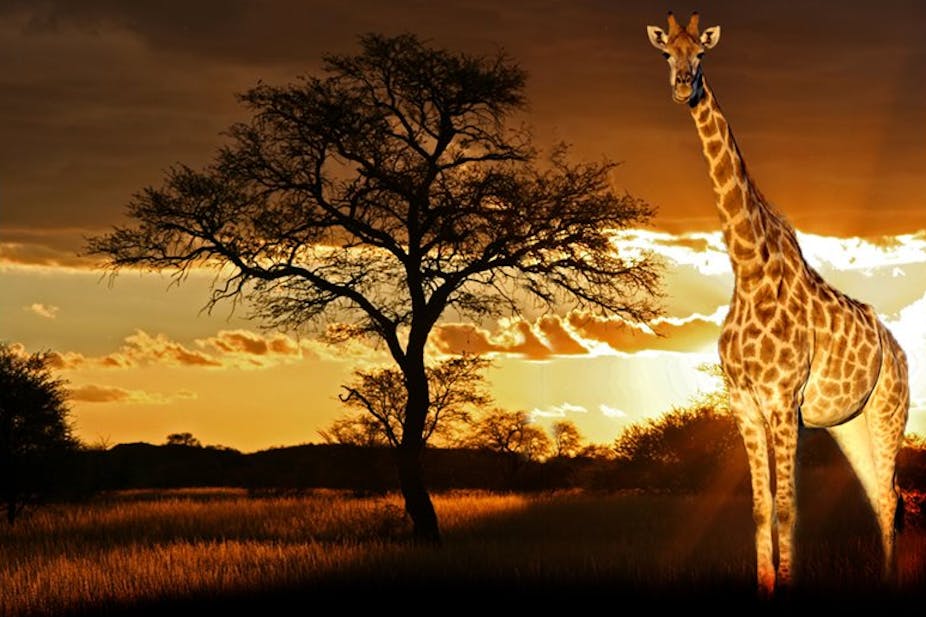There are less than 80,000 giraffes left in the wild and some subspecies of giraffes are close to extinction. Giraffes are endemic to Africa and all those found elsewhere in the world originate from the continent.
Giraffes are an iconic animal of the continent’s savannah and are loved symbols of wildness and the beauty of nature. Imagine looking at Africa’s wildlife and not seeing any giraffes. This is a strong possibility, if giraffes and their habitat are not conserved properly.
Giraffes in Africa are particularly under threat due to habitat fragmentation and degradation. Their habitat is being increasingly broken up through development, urban sprawl and agricultural intensification. Bush meat hunting and poaching are also major threats.
There are several species of giraffe across Africa. East Africa’s giraffes have lost 70% of their natural habitat and wildlife within the last three decades. The West African giraffe is considered endangered and of high conservation importance according to the International Union for Conservation of Nature’s Red List. In 2010, the Rothschild’s giraffe – located mostly in Uganda and Kenya – was also put on the list.
Giraffe are used to migrating to find better foliage, preferred tree species and favourable diet. In constrained and fenced areas they are forced to feed on less preferred and low-quality material. This puts the animals under nutritional stress during critical periods and when deciduous trees don’t have sufficient material to feed on.
There is some good news. Giraffe are currently common both inside and outside a number of protected areas in South Africa, as well as across the sub-region. In southern Africa they have been reintroduced to areas where they had been eliminated.
The population appears to be increasing in South Africa and continues to be reintroduced to areas within its natural range. The Kruger National Park estimate was 5500 individuals in 2004 compared to between 7000 and 10,800 individuals currently. Similarly, the estimate for the country’s northern Limpopo Province in 2004 was 3000 compared to 9688 currently.
In South Africa, the private sector has also played a major role in improving giraffe numbers. But this carries risks which are not being addressed.
The role of the private sector
Private game ranches been largely responsible for restoring giraffe to many parts of their former natural range in South Africa.
Our unpublished data estimates there are between 11,299 and 13,850 giraffe across 12,000 private farms. Most are wild and free-roaming within the fenced areas. This means they aren’t captive-bred or kept in enclosures and given supplementary food. Most are kept on adequately sized properties. But giraffe are also kept and bred on game ranches as small as 20 hectares. This is a problem because complications can arise like diseases, parasites and poor health.
In addition, many giraffe have been introduced to areas that historically may not have been part of their natural range, known as extra-limital introduction.

Giraffe are an attractive ecotourism and trophy-hunting animal. The private sector will therefore continue to stock, trade and increase their numbers.
The private ownership of giraffe and other wildlife species has helped to increase population numbers across the country. It is helping save the rhino from extinction and could be an option to save more wildlife species on the continent. The idea is controversial. But it can make a significant contribution to the success of species.
While a welcome development in terms of preserving the species, the restocking by private sector players carries dangers as the sector is unregulated and driven largely by economic gains. Given that the game ranching industry is driven by economic value little attention is given to the vegetation and the resources.
Measures need to be taken to ensure that the private sector involvement is done in a sustainable and safe way.
A free-for-all that must end
The following steps would go a long way.
Private landowners should be encouraged to form conservancies to reduce the effects of habitat fragmentation and reduce habitat degradation from overstocking.
Game ranches should also be required to undertake a habitat analysis before they can own a giraffe. Few game ranches do this. The habitat assessment should provide recommendations about the viability of the ranch and the introduction of the species. Many giraffe have died because they could not adapt to the environment. Proper regulations would limit these deaths and protect the habitat.
Robust assessments should be made of the impact on vegetation and other ecosystem processes when giraffe are introduced into areas considered extra-limital. And there should be research into appropriate habitats.
DNA and genetic material should be collected for assessing genetic diversity, describing potential inbreeding and informing translocation management frameworks.
Appropriate giraffe management and legislation for the wildlife sector should be supported and regulations put in place to prevent the importation and exportation of giraffe types, and
A large-scale stud book, which documents the demographic history of each individual giraffe, could be established to prevent inbreeding.
These interventions could be tied together by the drafting and adoption of a biodiversity management plan for giraffes. Supporting the development of appropriate giraffe management and legislation for the wildlife sector will help to stabilise numbers.
Little-to-no scientific information is currently available about giraffe in the arid regions and on private game ranching areas. The lack of long-term studies remains the most limiting factor in understanding the home range, spatial ecology, dynamics and movements of giraffe.

